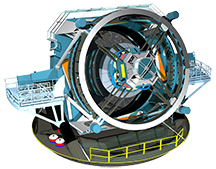A 3-D movie of the universe, no glasses needed: construction begins on Large Synoptic Survey Telescope
August 21, 2014
 |
|
An artist's rendering of the LSST telescope (photo courtesy of LSST/2013) |
WEST LAFAYETTE, Ind. — Two Purdue University physicists are part of an international project to create a telescope that will survey more of the universe than all of the previous telescopes combined.
Professors Wei Cui and John Peterson along with their students and staff researchers have contributed to the design and testing of plans for the Large Synoptic Survey Telescope, or LSST, for which the National Science Foundation approved a construction budget not to exceed $473 million on Aug. 4. This act marked the official federal start of the LSST project and is the culmination of more than 10 years of developing, planning and reviewing the telescope concept.
The 27-foot diameter Large Synoptic Survey Telescope is expected to take more than 800 panoramic images each night, canvassing the entire sky twice each week. It will capture a field of view 3,100 times larger than that of the Hubble Space Telescope and will include one of the largest digital cameras ever constructed, at 3,200-megapixels.
It also will rapidly scan the sky and capture the evolution and motion of objects over time, creating a 3-D "movie" of the universe, said Cui, who is Purdue's representative on the LSST Board and a part of the LSST Dark Energy Science Collaboration.
"During 10 years of data collection this telescope will trace billions of remote galaxies, unlocking some of the mysteries of dark matter and dark energy," he said. "It will be able to follow objects in action, like exploding supernovae and potentially dangerous near-Earth asteroids. In its first week of observation alone it is set to surpass the combined surveys of all of the previous telescopes, and the images and data will be shared with the public. Anyone with a computer will be able to virtually fly through the universe as they view the images and 'movie' of the universe."
Peterson, who is the LSST photon simulation lead and has produced terabytes of simulated images at Purdue, said that in addition to the usual images of stars and galaxies, the telescope will provide 3-D maps of dark matter distribution throughout the universe.
"Dark matter and dark energy appear to control how the universe evolves and expands, but they are two of the biggest puzzles in astronomy and physics," he said. "The sensitive measurements taken by the LSST will offer exciting insights into both the properties of dark energy and distribution of dark matter and their role in the universe."
Peterson leads the Photon Simulator, or PhoSim, project within LSST. He is a co-creator of the PhoSim software, which simulates astronomical images one photon at a time. The software takes into account the physics of the atmosphere, telescope and camera, and how light propagates through it. PhoSim is being used to test all of the software that is being constructed to analyze images from the telescope. Peterson leads the effort to develop, validate and expand the use of PhoSim and is the PhoSim convener in the LSST Dark Energy Science Collaboration.
Cui is a member of the LSST Dark Energy Science Collaboration and he and his group have used simulations to learn how to reconstruct dark matter maps. He also helped verify the sensor physics and simulated the calibration telescope for PhoSim.
LSST project activities are supported through a partnership between the National Science Foundation and the Department of Energy. NSF supports the project through a cooperative agreement managed by the Association of Universities for Research in Astronomy, or AURA, which is a consortium of 39 U.S. institutions and six international affiliates that operates world-class astronomical observatories.
The Department of Energy-funded effort is managed by the SLAC National Accelerator Laboratory. The Department of Energy funded the work of both Cui and Peterson.
Additional LSST funding comes from private donations, grants to universities and in-kind support from institutional members of LSST Corporation. LSST Corporation, or LSSTC, is a non-profit consortium of universities and other research institutions that supported the project’s early development.
Purdue has been a member of the project since 2008. In addition to Cui and Peterson, Purdue professors who have been involved in LSST include physics professor John Finley, computer science professors Christoph Hoffmann and Voicu Popescu, and adjunct professor of physics Ian Shipsey.
Writer: Elizabeth K. Gardner, 765-494-2081, ekgardner@purdue.edu
Sources: Wei Cui, 765-494-5395, cui@purdue.edu
John Peterson, 765-494-5193, peters11@purdue.edu
Related websites:
Purdue Department of Physics and Astronomy: http://www.physics.purdue.edu
Related releases:
Purdue part of project to create telescope of astronomical proportions: https://news.uns.purdue.edu/x/2008a/080108ShipseyLSST.html

